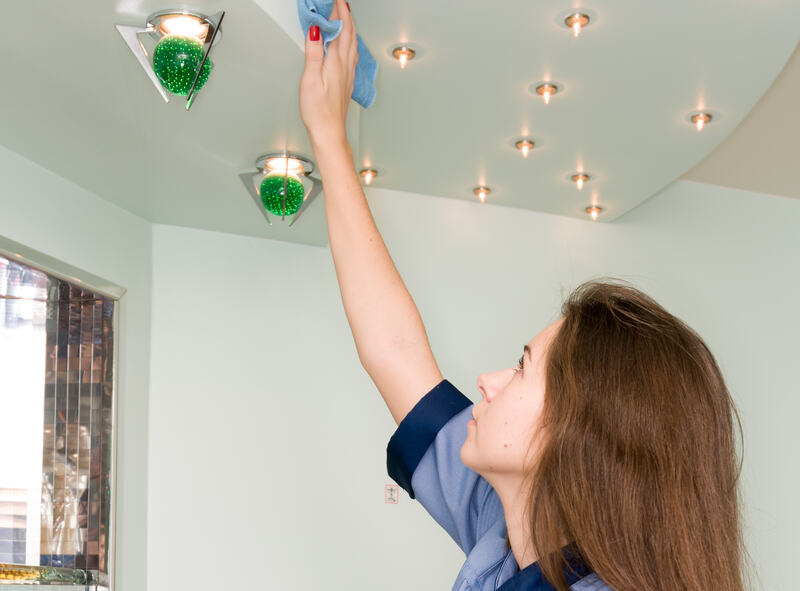Mould is a common household problem that usually appears on the ceiling which is unsightly and harmful to your health. That is why, it is important to understand how to clean mould off ceiling.
In this article, we will not only discuss how to clean mould off ceiling using natural and commercial products, but also the reasons why mould grows on ceilings, how to identify it, and the health risks associated with it. Stay tuned for tips on preventing future mould growth as well!
Why Does Mould Grow on Ceilings?
Mould grows on ceilings primarily due to excessive moisture and poor ventilation, which creates an ideal environment for fungal spores to thrive.
Moisture serves as the crucial catalyst in mould growth, providing the necessary nourishment for spores to germinate and spread. Inadequate ventilation exacerbates the issue by trapping the moisture indoors, allowing it to accumulate and encourage mould development.
Poor airflow hinders the dispersion of fungal spores, leading to their concentration in one area, such as ceilings, where they can colonise and proliferate rapidly.
How to Identify Mould on Ceilings?
Identifying mould on ceilings involves looking for discolouration, musty smells, and any visible fungal growth, often requiring expert advice for accurate identification.
Discolouration on ceilings can range from green, black, or grey patches, indicating the presence of mould. The musty odours associated with mould are distinctive and often linger in the affected area. If you notice peeling paint or bulging wallpaper, these could also be signs of mould lurking beneath the surface.
Professional assessment is crucial in determining the extent of the mould infestation and identifying the underlying cause. Trained professionals have the necessary tools and knowledge to conduct thorough inspections, which may include air quality testing to confirm the presence of mould spores.
To spot mould early on, routinely inspect areas prone to moisture such as bathrooms, kitchens, and basements. Use a torch to check dark corners and hidden spaces where mould can thrive unseen. If you suspect mould but are unsure, consider reaching out to an experienced mould remediation specialist for guidance.
Health Risks of Mould on Ceilings
Mould on ceilings can pose significant health risks, including respiratory issues, allergic reactions, and other severe complications, especially for individuals with compromised immune systems.
Mould exposure indoors can lead to irritation of the eyes, skin, throat, and lungs, triggering symptoms such as coughing, wheezing, and shortness of breath. For those sensitive to allergens, mould spores can cause allergic reactions like nasal congestion, sneezing, and skin rash. Prolonged exposure to mould may exacerbate asthma symptoms and even contribute to the development of asthma in susceptible individuals. It’s crucial to address mould infestations promptly to prevent these health risks.
How To Clean Mould Off Ceiling?
Cleaning mould off ceilings requires a combination of safety precautions, appropriate supplies, and effective cleaning techniques to ensure thorough removal and prevent recurrence. Here is a further explanation of how to clean mould off ceiling.
a. Safety Precautions
Before cleaning mould off ceilings, it’s crucial to take safety precautions to mitigate health risks, including wearing protective gear such as masks and gloves.
It’s important to ensure proper ventilation in the area, such as opening windows or using fans, to avoid inhaling harmful spores. Covering exposed skin with long sleeves and trousers can also protect against skin irritation. Using designated cleaning products specifically designed for mould removal is essential to effectively eliminate the problem without causing further harm.
When working with mould, make sure to dispose of contaminated materials properly and seal them in airtight bags before removal to prevent further spread. Regularly washing hands and other exposed areas after cleaning can help prevent any potential health issues that may arise from contact with mould spores.
b. Supplies Needed
The supplies needed for cleaning mould off ceilings include effective cleaning products like mould spray, mould and mildew remover, and also mould and mildew blaster. Alongside these powerful products, you will also require essential tools such as scrubbing brushes, microfibre cloths, and protective gloves for a thorough cleaning process.
You can easily purchase these cleaning products and tools from local hardware stores, supermarkets, or online retailers. Many specialised cleaning supply stores offer a wide range of mould removal products to cater to different preferences and budgets.
c. Steps to Clean Mould off Ceilings
To clean mould off ceilings, start by spraying the affected area with a mould remover spray, followed by scrubbing with a bleach solution and a scrub brush for thorough cleaning.
Once the affected area has been sprayed and scrubbed, rinse the ceiling with clean water to remove any remaining mould residue.
For stubborn mould stains, you can also create a paste using bicarbonate of soda and water, applying it to the affected areas and allowing it to sit for a few hours before scrubbing again.
Ensure proper ventilation in the room while cleaning to avoid inhaling fumes from cleaning products.
How To Clean Mould Off Ceiling Naturally?
Natural ways to clean mould off ceilings involve using eco-friendly solutions such as vinegar, baking soda paste, and tea tree oil, which are effective and non-toxic alternatives to chemical cleaners. Here is a further explanation of how to clean mould off ceiling naturally.
a. Vinegar Solution
A vinegar solution is a highly effective and eco-friendly method for mould removal, capable of killing 82% of mould species.
Prepare the solution by simply mixing equal parts of distilled white vinegar and water in a spray bottle. The acidity of vinegar not only kills mould but also prevents it from growing back. This natural solution is non-toxic, making it safe for both your family and the environment.
To use, spray the solution onto the affected area and let it sit for at least an hour before scrubbing with a brush or cloth. For stubborn mould, you can even apply the vinegar directly without dilution.
b. Baking Soda Paste
Bicarbonate of soda paste is another natural cleaning solution that effectively removes mould and helps deodorise the affected area.
Making a bicarbonate of soda paste is simple – just mix water with bicarbonate of soda to create a thick consistency. The natural properties of bicarbonate of soda work to break down mould and mildew, while its deodorising abilities help eliminate any musty odours.
After preparing the paste, apply it directly to the mould-affected areas, ensuring complete coverage. Let the paste sit for a few hours to work its magic before scrubbing it off with a damp cloth. The gentle abrasiveness of the bicarbonate of soda helps to lift the mould from surfaces without causing damage.
c. Tea Tree Oil Solution
Tea tree oil solution is a powerful natural cleaner for mould removal, known for its antifungal and antibacterial properties.
To create an effective tea tree oil cleaning solution, you’ll need a spray bottle, distilled water, and of course, tea tree oil. Fill the spray bottle with water and add about 10-20 drops of tea tree oil. Shake well to ensure the oil is evenly distributed.
Now, you’re ready to tackle mould! Spray the solution directly onto the affected areas and let it sit for at least 30 minutes. The antifungal properties of tea tree oil will penetrate the mould and help in its removal.
What Are the Commercial Products Available to Clean Mould off Ceilings?
There are several commercial products available for cleaning mould off ceilings, including:
a. Mould Remover Sprays
Mould remover sprays are popular products known for their immediate effectiveness in eliminating mould.
These sprays are designed to target mould and mildew, which are not only unsightly but can also pose health risks if left untreated. The unique formulation of these products allows them to penetrate deep into porous surfaces, ensuring thorough removal of mould stains.
b. Bleach Solutions
Bleach solutions are highly effective for mould removal, capable of killing mould spores on contact and preventing further growth.
When preparing a bleach solution, it’s crucial to follow the proper dilution instructions to ensure effectiveness and safety. Typically, a mixture of 1 part bleach to 10 parts water is recommended for mould remediation.
Before applying the solution, make sure to protect yourself with rubber gloves, eye protection, and a mask to avoid direct contact with the bleach. Ventilation is also key when using bleach, as inhaling its fumes can be harmful.
Once the solution is mixed, apply it directly to the affected areas using a spray bottle or cloth. Allow it to sit for at least 5-10 minutes before scrubbing the mould away.
c. Mould Killing Paints
Mould-killing paints provide a preventive measure against mould growth by incorporating antifungal properties into the paint.
These specialised paints work by creating a hostile environment for mould spores to thrive, effectively killing any existing mould and preventing future growth. The antifungal properties in the paint create a protective barrier, inhibiting the growth of mould on surfaces where the paint is applied.
The application process is straightforward, similar to regular paint application. One simply needs to ensure that the surface is clean and dry before applying the mould-killing paint. The benefits of using such paints are numerous, including improved indoor air quality, reduction of health risks associated with mould exposure, and prolonged durability of surfaces by preventing mould-related damage.
How to Prevent Mould Growth on Ceilings?
Preventing mould growth on ceilings involves maintaining proper ventilation, using dehumidifiers, and employing the best air purifiers to reduce moisture and improve air quality.
Proper ventilation is crucial as it helps in circulating the air and preventing stagnant pockets where mould can thrive. Using dehumidifiers can effectively control the humidity levels, creating an environment that is inhospitable to mould growth.
Investing in quality air purifiers with HEPA filters can further aid in removing mould spores and other pollutants from the air, promoting a healthier indoor atmosphere. By integrating these strategies, you can significantly reduce the likelihood of mould formation on ceilings and maintain a clean, mould-free living space.
The above is a complete explanation of how to clean mould off ceilings, both naturally and by using over-the-counter commercial products, as well as prevention tips.
However, when dealing with persistent mould issues, it’s crucial to ensure a thorough and professional cleaning to prevent its recurrence and safeguard your home environment. With TEKA Cleaning’s residential cleaning services, you can trust our expert team to eliminate mould effectively, leaving your ceilings clean and free from harmful spores.
Don’t compromise on the cleanliness and safety of your home. Contact TEKA Cleaning today at 01233 751 544 and let us handle the task with precision and expertise.
Read also:










